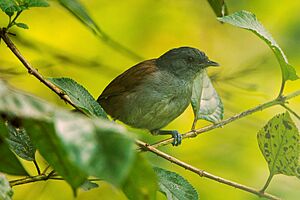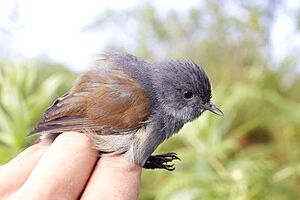African hill babbler facts for kids
Quick facts for kids African hill babbler |
|
|---|---|
 |
|
| In Kenya | |
| Conservation status | |
| Scientific classification | |
| Synonyms | |
|
The African hill babbler (Sylvia abyssinica) is a small bird that lives in the forests of Africa. It belongs to the Sylviidae family, which includes many types of warblers. This bird is known for its beautiful song and its shy nature.
Contents
What is the African Hill Babbler?
The African hill babbler is a robin-like bird that lives in trees. It has a bright reddish-brown back and a cool grey head. Its belly is a lighter grey. These birds are quite small, usually weighing about 14 to 25 grams. That's like the weight of a few grapes! They are also about 13 to 15 centimeters long, which is about the length of your hand.
What Does it Look Like?
Imagine a small bird with a thin beak. Its back is a bright reddish-brown, and its head and the back of its neck are a contrasting grey. Its tummy is also grey, but a bit lighter, and sometimes has faint white lines. The sides of its body and its upper legs might have a yellowish tint. This bird has brown eyes that can turn red, especially when it's time to find a mate! Its beak is black on top and lighter underneath, and its legs are a bluish-grey.
What Does its Song Sound Like?
The African hill babbler has a beautiful, rich song! It sounds like a lovely, musical whistle, almost like a thrush or an oriole. Its song has different parts, with lots of changes in how high or low the notes are. Sometimes you might even hear some scratchy sounds or lower whistles mixed in.
Where Does the African Hill Babbler Live?
The African hill babbler lives in different parts of western and central Africa. You can find it in highland areas, from southeastern Nigeria all the way east to central Ethiopia. It also lives south to northwestern Mozambique.
What Kind of Home Does it Like?
This bird loves to live in montane forests, which are forests found in mountains. It also likes nearby secondary forests, which are forests that have grown back after being cut down. You can often find them in thick bushes at the edge of forests or in clearings. They also like to live in gallery forests, which are forests that grow along rivers.
How Does the African Hill Babbler Behave?
African hill babblers usually live in pairs. They spend their time looking for food, often staying within 2 meters of the ground. They pick insects off leaves and also eat fruit. Sometimes, they will fly higher into the trees to find food. They also like to join groups of different bird species that are foraging together. This bird usually stays hidden among climbing plants and vines. Because it's so good at hiding, you're most likely to know it's there by hearing its song!
How Scientists Study the African Hill Babbler
Scientists first described the African hill babbler in 1840. A German scientist named Eduard Rüppell gave it its first scientific name. It was first found in the Simen Mountains in Ethiopia.
There are six different types, or subspecies, of the African hill babbler:
- S. a. monachus – Found near Mount Cameroon.
- S. a. claudei – Lives on Bioko Island.
- S. a. ansorgei – Found in west-central Angola, southeastern Democratic Republic of Congo, and western Tanzania.
- S. a. stierlingi – Lives in eastern and southwestern Tanzania, the Nyika Plateau in northeastern Zambia, northern Malawi, and northwestern Mozambique.
- S. a. stictigula – Found in northeastern Zambia, northern Malawi, and northwest Mozambique.
- S. a. abyssinica – Lives in central Ethiopia, eastern South Sudan, eastern Uganda, western and southern Kenya, and northeastern Tanzania.
For a while, some scientists thought the black-headed Rwenzori hill babbler was just another type of African hill babbler. They noticed it had similar calls and actions. However, other scientists now believe it is a separate species.
Images for kids





